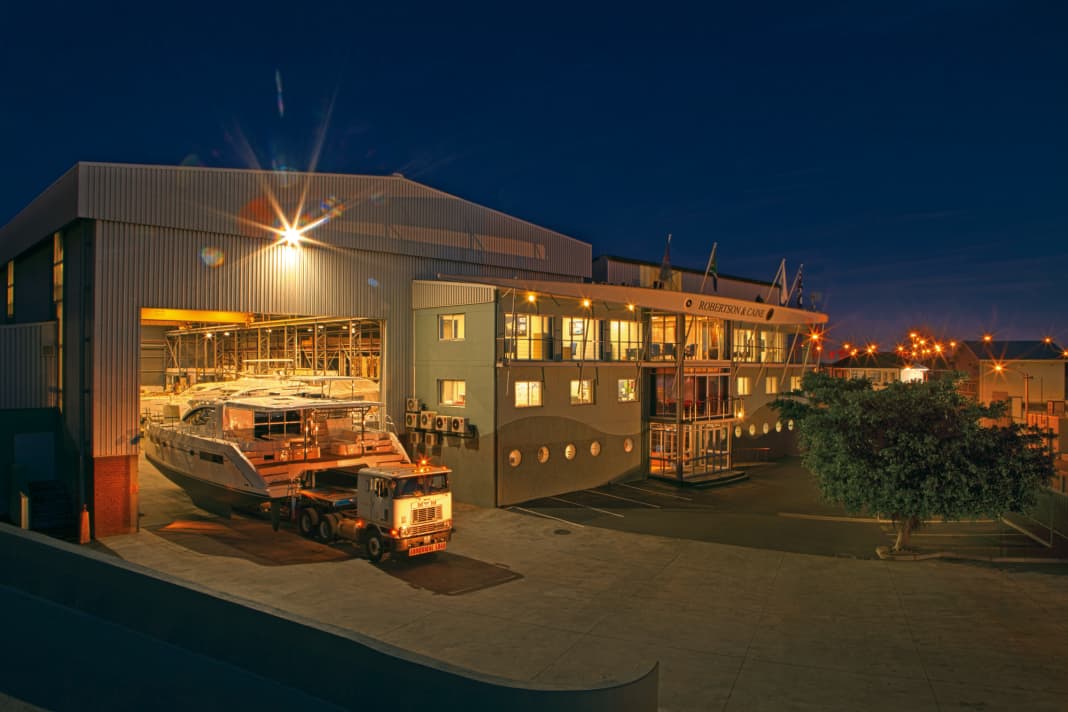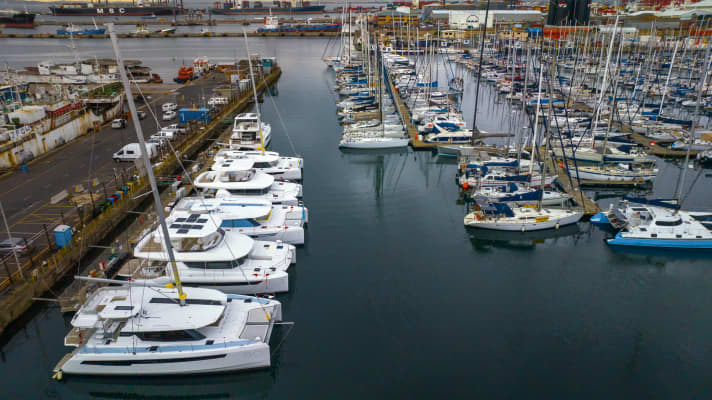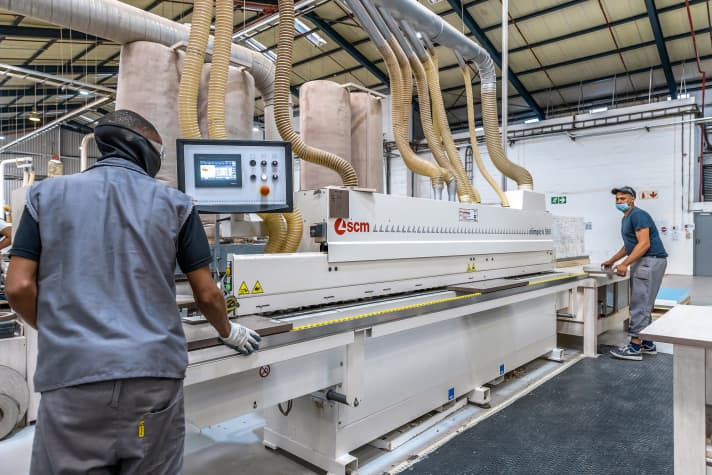Catamaran shipyard: Visit to Robertson & Caine - Cape Town's dream factory






Tens of thousands of sailors around the world know their boats - albeit under a different name. As Sunsail 454 or Moorings 4200, the cats from Cape Town are chartered worldwide. However, few people have heard of the shipyard. Yet it can look back on a long and unique history in the multihull market.
In fact, Robertson & Caine can be seen as a kind of "hidden champion" in the colourful world of yacht building. The company, which was founded in 1991, does keep some distance between itself and world market leader Lagoon in terms of unit numbers and the breadth of its model range. However, the South Africans, who sell their models under their own brand "Leopard" and have the status of an exceptional company in many respects, are roughly on a par with Fountaine Pajot and Bali.
Decades of licence production for Moorings, and later also for Sunsail, helped their cruising cats to achieve enormous popularity. Especially in the Caribbean, Florida and the Bahamas, the boats from South Africa dominated the charter market for a long time and still characterise it today.
Delivery on own keel from Cape Town to Europe
Due to the almost year-round use in their home waters and the sometimes sporty sailing conditions in the trade winds, Robertson & Caine catamarans have always been considered particularly robust. This is also due to the fact that until a few years ago, almost all of the ships were delivered on their own keels - from Cape Town directly to the Caribbean or Europe.
This long-cherished peculiarity established the reputation of special seaworthiness. It is reminiscent of the image benefit that German car manufacturers derive from the fact that there is no general speed limit on motorways between Flensburg and Garmisch. It may be a myth, but it is helpful for marketing purposes and has therefore been cultivated to this day.
Of course, it would be an inadmissible shortcut to reduce the model range solely to its suitability for rough water. In any case, this has its origins not only in years of practice under sail, but at least as much in the local conditions in Cape Town. There, in this Mecca for surfers, the weather can change within hours and the south-easterly wind known as the "Cape Doctor" likes to send strong gusts down Table Mountain, causing the sea to boil. Anyone who designs, builds and tests boats here knows exactly what they sometimes have to put up with.
Agile sailing characteristics and well thought-out layouts
In addition to their taking qualities, Robertson & Caine's Leopards are also characterised by their agile sailing characteristics. They have left out the interim trend towards self-tacking jibs, because an overlapping genoa offers more propulsion in light winds and a better stance at a slant.
But the South Africans also continue to set new standards in terms of cruising comfort, for example with the introduction of the forward cockpit accessible from the saloon. Unlike the cockpit aft, this deck layout offers additional seating where there is always a breeze, whether under sail or at anchor. The door on the forward superstructure also improves ventilation inside the boat. All models in the current sailing catamaran programme have this arrangement: from the Leopard 42 to the Leopard 50. The motor catamarans also offer a forward exit from the saloon.
Robertson & Caine is spread across five locations in Cape Town
Like the boats themselves, their production follows its own path - some historically determined, others determined by local conditions. Perhaps the most astonishing thing about Robertson & Caine is that to this day it is theoneshipyard does not exist.
Instead, production is spread across no fewer than five sites in the industrial area to the east of the city centre. Four football stadium-sized halls are dedicated to actual boat building. The fifth complex, which is also the most modern and efficient, is used for computerised wood cutting and furniture assembly. Together they cover 60,000 square metres. The fragmented structure, which has gradually grown, has both advantages and disadvantages. It complicates logistics because motors, fittings, chargers and electronics cannot be delivered centrally and installed directly. The same applies to resins, glass fibre mats and foam sandwich cores. Where other series production yards produce all or almost all models under the same roof, on one or two production lines, Robertson & Caine works in a highly compartmentalised manner.
However, this significantly reduces the complexity of the line, which makes it easier to deploy less well-trained or newly recruited boat builders and fitters. The most popular models, the Leopard 45 and the 40 Power Cat, each have their own dedicated factories that produce nothing other than this one type. This simplifies familiarisation and the rectification of any manufacturing defects, provided they are identified and traced at the end of the production line.
Two quality checks and extensive test runs for every cat from Robertson & Caine
Each boat undergoes a total of two quality checks before being transported. By the time the heavy goods transporter arrives, all quirks, kinks and malfunctions must have been eliminated. There are model-specific checklists and foremen who work independently of the fitters. Sometimes five or six specialists scurry through the ship at this last station.
But that's not all. From the shipyard, the boat is lorried at night to the delivery pier at the yacht club, where each cat is rigged for a trial run and all units are subjected to a comprehensive function test in the water for hours.

There are then five, six, ten boats in a row, with running engines, quietly humming generators and air conditioning systems producing cooling air. Only after passing this third inspection station are they ready for delivery, which is now almost always carried out by freighter, usually on deck, with the mast upright, if this is possible.
2,300 employees at five locations: The shipyard has the highest vertical range of manufacture of the major manufacturers of travelling cats
This is another area in which Robertson & Caine differs from its French competitors. While the Europeans have already standardised and industrialised their production to a much greater extent due to high labour costs and an increasing shortage of labour, have simplified processes, shortened distances and carry out checks continuously instead of mainly at the end, the South Africans can draw on a full range of personnel.
The company in Cape Town currently employs 2,300 people for an annual production of around 200 to 225 catamarans. By comparison, Fountaine Pajot manages the same workload with 600 employees, barely more than a quarter. However, the vertical range of manufacture at Robertson & Caine is much greater than that of the competition, which buys in more semi-finished products and produces less itself.
Robertson & Caine builds almost on its own
Managing Director Theo Loock's Leopard crew build their own hull and deck moulds, mill the foam sandwich cores on site and glue the edge banding onto the plywood panels that are later used to create the interior. However, this does not fully explain the additional labour required. It also has to do with the lower qualifications of some of the workers, but above all with their much lower pay. The company can simply afford to employ more people.
This goes so far that when Theo Loock joined the company two and a half years ago, he deliberately invested more in quality and limited the production figures. Although 250 catamarans per year would be feasible with the current infrastructure, the top manager brought in by co-founder John Robertson decided to deliberately not utilise the capacity. Instead, he promoted further training, employee retention and team spirit in the midst of the coronavirus pandemic, which enabled him to mobilise the entire company.

Since then, Loock has gradually modernised its production. Robertson & Caine is no longer inferior to the best, especially in the GRP sector, but also in the joinery. Hulls and decks are increasingly laminated using the vacuum infusion process, which ensures a more homogeneous, stronger fibre composite. Vinylester is used as the resin and NPG gelcoat for high osmosis protection. Smaller components such as hatch covers are produced using the RTM (Resin Transfer Moulding) process, which results in a perfect surface finish on both sides.
Robertson & Caine is regarded as a benchmark- also for the competitors
As far away from the European centre of modern yacht building as the company in Cape Town may be, as different as the philosophy may be, as great the personnel costs - technically, the South Africans have nothing to hide. On the contrary, they operate at eye level. Their solidity and practicality are appreciated even by their competitors and are even regarded as a benchmark, even if this is only recognised in small circles.
And who knows: perhaps Robertson & Caine's best days are yet to come. In mid-February, Vox Ventures, a company belonging to the Czech investor group PPF, which together with the Beneteau Group holds a majority stake in the world's largest charter company Dream Yachts, announced the takeover of the shipyard.
Co-founder John Robertson handed over the reins years ago. His son, however, remains as a continuum in the company
When asked about the reasons for the acquisition, Didier Stoessel, Chief Investment Officer of PPF, said that "the quality of the work, the skills and the expertise of the South African boat builders" were the deciding factors. His company wants to build on this "excellence" in the further development of the brand.
New top model to come
For John Robertson, who founded the company together with Jerry Caine 32 years ago and made it big, it is now time to let go completely. But the shirt-sleeved man of action, who once made a name for himself in the region by building lightweight monohull racing yachts, doesn't dwell on his sadness for long. "Although it's a bittersweet moment, I'm confident that our legacy will continue to grow."
The portfolio too. Internally, there is talk of a new top model in the sailing catamaran segment - a successor to the Leopard 58. The current production lines do not allow for larger units.
Franck Bauguil, who manages the global marketing of Robertson & Caine production, does not see the exclusive distribution being jeopardised by the PPF takeover. "The long-standing relationship with Moorings and Sunsail is here to stay."

